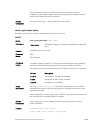
NOTE: If you do not specify this option, neighbors
corresponding to the default VRF are displayed.
interface
(OPTIONAL) Enter one of the following keywords and slot/
port or number information:
• For a 10-Gigabit Ethernet interface, enter the keyword
TenGigabitEthernet then the slot/port information.
• For a 40-Gigabit Ethernet interface, enter the keyword
fortyGigE then the slot/port information.
• For a port channel interface, enter the keywords port-
channel then a number.
• For a VLAN interface, enter the keyword vlan then a
number from 1 to 4094.
Defaults none
Command
Modes
EXEC
Command
History
Version Description
9.7(0.0) Added support for VRF.
9.2(1.0) Introduced on the Z9500.
9.2.(0.0) Added support for showing BFD status on the S4820T,
S4810, and Z9000.
9.1.(0.0) Added support for OSPFv3 on the S4810 and Z9000.
8.3.19.0 Introduced on the S4820T.
7.8.1.0 Added support for the C-Series.
7.4.1.0 Introduced on the E-Series.
Usage
Information
If you enable BFD at the global level, show ipv6 ospf interface shows the BFD
provisioning.
If you enable BFD at the interface level, show ipv6 ospf interface shows the BFD
interval timers.
Example
Dell#show ipv6 ospf 3 interface tengigabitethernet 1/2
TenGigabitEthernet 1/2 is up, line protocol is up
Link Local Address fe80::201:e8ff:fe17:5bbd, Interface ID
67420217
Area 0, Process ID 1, Instance ID 0, Router ID 11.1.1.1
NetworkType BROADCAST, Cost: 1, Passive: No
Transmit Delay is 100 sec, State DR, Priority 1
Interface is using OSPF global mode BFD configuration.
Designated router on this network is 11.1.1.1 (local)
No backup designated router on this network
Timer intervals configured, Hello 10, Dead 40, Wait 1,
Retransmit 5
1376
Open Shortest Path First (OSPFv2 and OSPFv3)


















